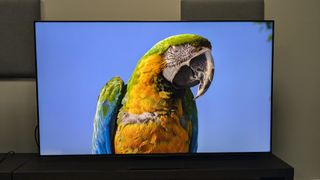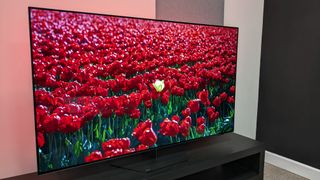These are my top 3 TVs I’ve reviewed so far in 2024, from elite OLED to affordable mini-LED
This year has seen incredible strides forward in the TV world, with refinements to OLED and mini-LED technology enhancing the latest crop of sets. OLED still rules in 2024, but mini-LED is fast catching up and leveling the field for which models deserve the title of best TV.
Highlights so far have included Sony’s decision to move from OLED to mini-LED for its flagship TV, the brilliant Sony Bravia 9, which makes use of its new XR Backlight Master Drive technology (with 22-bit LED drivers) to deliver more refined local dimming. We’ve also seen Samsung, LG and Philips claim that their OLED TVs can reach peak brightness of over 3,000 nits – something we’ve yet to confirm in our tests – and have measured peak brightness of over 1,000 nits for the first time on mid-range OLEDs such as the LG C4.
Micro lens array (MLA) technology is now in its second generation, put to good use in OLED TVs like the LG G4 . Meanwhile, QD OLED is in its third generation, powered by one of the best OLED TVs launched this year, the Samsung S95D (spoiler: you won’t hear the last of this TV). Even mini LED has evolved beyond Sony’s Bravia 9, with TVs from brands like TCL hitting an eye-watering 6,500 nits.
Of the TVs I reviewed this year, from the most premium OLED to budget QLED models, several stood out from the crowd. These are the three best TVs I’ve reviewed in 2024.
1. Samsung S95D
The Samsung S95D is one of the best OLED TVs I’ve ever seen. In my review, I described it as “the standard-bearer for OLED in 2024”. Using QD-OLED technology (a combination of an OLED panel with QLED technology for extra brightness and color richness), the S95D delivers spectacular contrast, dazzling HDR highlights, and vibrant colors. The NQ4 AI Gen2 processor also ensures that it delivers incredibly well-defined and realistic textures and details.
The S95D’s main secret weapon is its OLED Glare Free display. This anti-glare technology uses a matte screen and an anti-reflective coating to effectively eliminate reflections – arguably one of OLED’s biggest problems. I described this OLED Glare Free display as “the star of the show” in my review, as I found that I could see even the darker and more challenging images in The Batman in bright viewing conditions – something other OLED TVs I’ve tested have struggled with.
But it’s not just the picture where the S95D shines, as this is also a well-equipped gaming TV, with an ultra-low 8.9ms input lag and four HDMI 2.1 ports supporting 4K 144Hz, VRR (with AMD FreeSync Premium Pro included), and ALLM. Combine that with the picture and you’ve got one of the best gaming TVs going.
The S95D looks fantastic too, with a ‘floating’ design thanks to its stand and wafer-thin depth. As a bonus, the built-in sound is good too, with controlled bass, good placement of effects and brilliant directional sound. It’s a premium purchase, without a doubt, but the S95D is easily the best TV I’ve reviewed this year. As I said in my review, it is “what OLEDs should aspire to.”
2. TCL-C855

The affordable mini LED TV market is a crowded one, with the likes of the Samsung QN85D, Hisense U7N, Hisense U6N and more aiming to offer the best value for money. I’ve seen and tested my fair share of affordable mini LED TVs this year (including the three I just mentioned) and one really stands out: the TCL C855. It’s worth noting that this TV is only available in the UK and Australia. The closest alternatives for US viewers are the TCL QM851G (which is a touch more expensive) or the Hisense U8N.
During my time with the C855, I was surprised by how good the picture looked, even straight out of the box. It delivers excellent black levels (especially for a mini-LED TV at this price point), vibrant colors, and realistic textures, with detail “close to that of the more premium Samsung S95D “, as I said in my review . The high brightness across the entire screen makes it an excellent TV for sports, and motion in both sports and movies is handled well (though sports will benefit from some settings tweaks).
The C855 also offers comprehensive gaming features for the money, with support for 4K 144Hz, Dolby Vision gaming, VRR (including AMD FreeSync Premium Pro), and ALLM. Gaming performance is silky smooth, and the C855’s picture quality makes it a great gaming TV too. It only has two HDMI 2.1 ports and an input lag of 14.6ms, which is a little higher than the best gaming TVs, but for the price it’s hard to argue against what the C855 delivers.
The real selling point for the C855, though, is its price, with the 65-inch model I tested costing £1,299 / AU$2,295. While that will still seem like a steep price to many, it represents exceptional value for money for a 65-inch TV offering this level of performance and features. As I said in my review, “you’ll struggle to find a better picture-packed Mini LED TV at this price.”
3. Philips OLED809

I was a fan of Philips’ 2023 mid-range OLED TV, the Philips OLED808, so I was naturally excited to see its successor, the new Philips OLED809 . I wasn’t disappointed. (It’s worth noting again that this is a UK-only TV – for US and Australian readers the LG C4 will be the nearest alternative.)
I’m also a fan of Philips’ Ambilight technology, a built-in feature that projects colored lights onto the wall behind the set. Ambilight adds an extra layer to the viewing experience, especially with bright and colorful movies (in my review it was Star Wars: The Last Jedi) and the vibrant, rich colors of the lighting technology give the OLED809’s image a sense that it extends beyond the screen.
In addition to Ambilight, the OLED809 delivers excellent picture quality, with rich detail, powerful contrast and of course dynamic colours. In my review I noted how the OLED809’s “punchy colours of La La Land with stunning accuracy”, but no matter what movie I watched, the OLED809 delivered a stunning picture.
The real surprise of the OLED809, however, is the sound quality. Despite only having a 2.1 speaker array, I found the sound to be powerful and accurate. When watching movies like The Batman And La La Land During testing, it showed the great balance of the TV’s speakers and the strong directional placement of sound effects. When I compared it to another mid-range OLED, the Panasonic MZ1500, I was surprised at how well it performed.
What’s more, the OLED809 has all the gaming bells and whistles you could want, and is competitively priced when compared to other mid-range OLEDs (the 55-inch we tested costs £1,499, while the 55-inch LG C4 costs £1,399). The OLED809 is one of the best mid-range OLED TVs I’ve tested.
